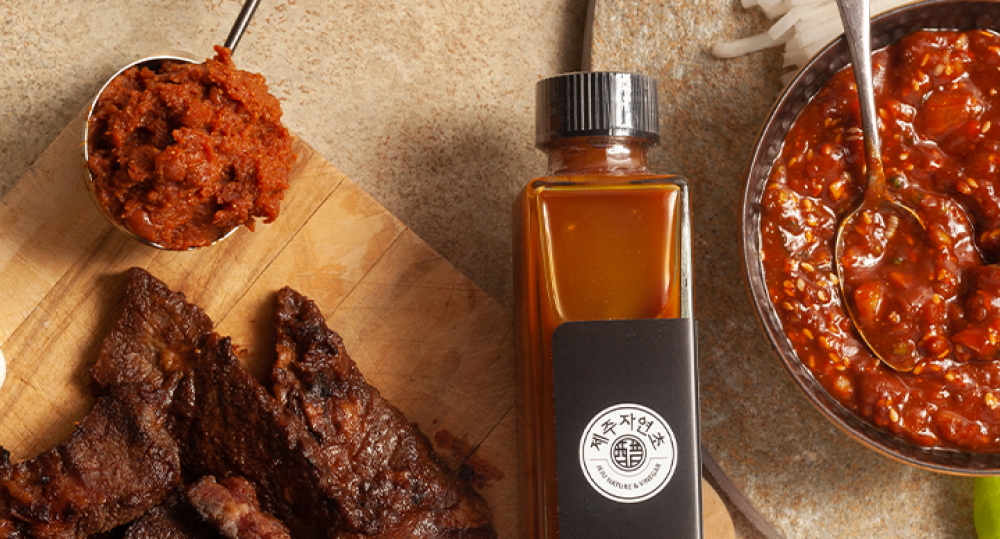As Korena food has gained popularity over the years in the U.S., its fame has been centered around smoky Korean BBQ meats and robust flavors of spicy, salty kimchi and more spicy, salty bubbling stews,” says Korean cooking instructor Shin Kim in her new cookbook, “Korean Vegetarian Cooking: Authentic Flavors in Simple Steps.” But the food Kim grew up with, the cooking that stayed with her, was vegetable-driven, with flavors she describes as “subtle and mild to deep and vivid.”
In November, Kim published an ode to the kind of everyday cooking she grew up with in Seoul and next month, she’ll teach a livestream cooking class on the subject with the Milk Street Cooking School (details here).
As with many cuisines, the best place to start when approaching Korean cooking is in the pantry, Kim says, and she starts her book accordingly, with a section devoted to her essential staples. These are ingredients that don’t just add flavor, they amplify and maximize everything you add them to.

“I live in Manhattan with a small kitchen, but when I make Korean food, I always make more than I need,” she says. “So many dishes are easy to freeze or made with fermented ingredients and store well. It’s important to know how to revive them.”
Below are six pantry staples Kim calls essential. Find more in her cookbook and join her livestream class next month!
Korean Fermented Soybean Paste (Doenjang)
Doenjang is a chunky, salty paste made by cooking and mashing soybeans into blocks, called meju, that are dried for weeks and fermented. The blocks then are washed, sun-dried, stacked in saltwater-filled crockpots and aged for months. The sediment that forms at the bottom of the pots becomes doenjang, while the liquid becomes soup soy sauce (more on this below). As Kim writes in her book, “It is a wondrous, laborious process by both nature and humans.”
The most well-known use for this paste is as a base for soup or stew. In her recipe for Gangdoenjang Jjigae, or Hearty Soybean Stew, in the book, Kim describes the dish as one that will take various forms depending on the season. Hers calls for sauteing the doenjang with sesame oil and garlic, before adding potatoes, squash, mushrooms and vegetable stock. She then adds tofu and peppers. “It’s a really hearty stew you can make in 10 to 20 minutes, but it takes like it’s been cooking a couple of hours at least,” Kim says.
You also can use the paste as the base of a stir fry, roasting it first before tossing in vegetables, or as a sauce for lettuce wraps. It doesn’t need to be cooked, however. Mix it into salad dressings, Kim says, or use a little to season raw or slightly cooked vegetables.
“It doesn’t have to be very pronounced in flavor. Add a little bit to dishes for more depth and dimension.”
Soy Sauce
In her book, Kim lists both conventional soy sauce—the kind that’s easy to find and contains flavor additives—and “Korean Soup Soy Sauce,” also known as house soy sauce and joseon soy sauce. If you are just getting into Korean cooking, she recommends using the easy-to-find stuff.
But if you want to go deeper into Korean cooking, she suggests exploring the traditional soup soy sauce, which is made only with soybeans, salt and water. It typically is lighter in color and has a saltier taste than mass market soy sauces. In either case, you can, of course, use soy sauce as a dipping sauce and in marinades, but also to stir into soups and stews, to cure eggs (find a recipe for Soy Sauce Eggs in her book) or the soy-pickled peppers known as gochu jangajji that Kim will teach in her Milk Street Cooking School class.
See here for more clever ways to use soy sauce.
Korean Fermented Red Pepper Paste (Gochujang)
Gochujang is the go-to seasoning for so many Korean dishes. It’s made by mixing the meju soybean blocks used to make doenjang with red pepper powder, sweet rice flour, salt and rice syrup. Use it as the base of a sauce or marinade to season vegetables, as Kim does with steamed eggplant in her book, or on meat, like shredded pork. (See our recipe for Miso-Gochujang Pulled Pork here.)
Or, whisk it into the batter of crispy pajeon, or scallion pancakes, a recipe Kim will be teaching in her Milk Street class. You could add gochujang on its own or mix it with doenjang before whisking into the pancake batter—an addition that turns pajeon into jangtteok, or savory pancakes seasoned with one or both of these fermented pastes.
Another common use is to mix gochujang with ketchup, sugar and soy sauce into a glaze to use on vegetables or crispy tofu. “Every Korean cook seems to have their own ratio of the perfect gochujang glaze,” Kim says, and hers comes from her mom.
Kim’s Gochujang Glaze
In a large skillet, mix together ¼ cup gochujang, ¼ cup ketchup, 2 tablespoons sugar, 1 tablespoon soy sauce and 2 garlic cloves, minced or grated. Bring to a boil over medium heat, remove from heat and set aside.
Korean Red Pepper Flakes (Gochugaru)
Another common red pepper-based seasoning is gochugaru, which is made with coarsely ground red pepper flakes and takes on a slightly sweet fragrance when heated. Its coarse texture and bright red color makes it a great garnish, but it’s also mixed into recipes to bring heat to everything from kimchi, soups and stews to noodle dishes and dumplings.
Toasted Sesame Oil
Kim uses toasted sesame oil most often as a finishing to add flavor and fragrance. Because it has a low smoke point, if she uses sesame oil to cook with, as in sautéing vegetables, she will mix it with regular cooking oil. Otherwise, she’ll keep the heat low. “If I’m using it for porridge, then I’m mixing the sesame oil with wet rice that’s been soaked, so I’m not trying to fry or sauté the ingredients, but still I make sure it’s not getting to a smoking point,” she explains. Because of it’s bold flavor, it’s great for mixing with other ingredients, like vinegar and soy sauce.
Sesame Seeds
Sesame seeds are used often as a garnish on Korean dishes, but Kim uses them in another way. She grinds toasted sesame seeds into a paste to add flavor and body to dishes, as in her Broccoli and Crumbled Tofu Salad. She’ll often use a mortar and pestle here, but a small spice grinder works, too. Or, as Kim likes to demonstrate in her classes, she puts the toasted, cooled sesame seeds in a zip-close plastic bag and rolls a rolling pin over them. In her Broccoli and Crumbled Tofu Salad, the ground sesame paste goes on top for added texture, like a chunky dressing. If you can’t find toasted sesame seeds, toast them yourself in a dry skillet over low heat.
“Once you have at least three items,” Kim says of this list of pantry essentials, “then there are so many ways to mix and match and use them in different dishes.”
Join Shin Kim for a livestream class on Korean Vegetarian Cooking on Thursday, April 1 at 6pm EST.
See here for more from the Milk Street Cooking School, including our full list of livestream classes and workshops, and our free, self-paced classes.
Join the conversation on Facebook, Twitter, Instagram and Pinterest.








